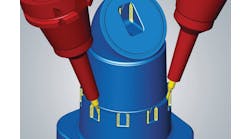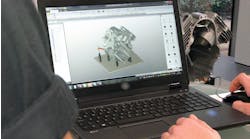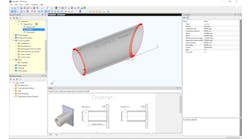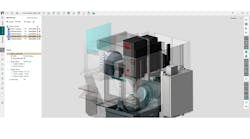Randy Theken's medical implant business was struggling to find contract manufacturers able to provide the all services it needed, so in 2016 he established Slice Mfg. Studios in Akron, Ohio. That made NextStep Arthropedix an advanced engineering and manufacturing business that started a contract machine shop.
Now, Slice has established itself as a one-stop shop with design, development, and manufacturing capabilities for medical device and industrial customers, including prototyping and mechanical testing, to final production and sterile cleaning/packaging. The high-end, full-spectrum "studio" is FDA-registered and ISO 13485-certified, with classed cleanrooms.
Mostly, Slice manufactures sophisticated, three-dimensionally contoured devices for small- to medium-sized customers requiring medical devices like acetabular hip cups, femoral stems, spinal cages, and the full complement of plates, screws, and other components that go with them.
It also produces industrial components for defense, down-hole drilling applications, and deep-sea underwater connections.
The medical implant industry in particular requires a high level of customization because implants include a family of components with many permutations. For example, because every person is different, a spinal cage may have three or four different angles of lordosis in addition to 15 different sizes. Those permutations mean that Slice has to make hundreds of discrete components — and program each component individually.
“In our business, what’s important is "speed to first good part.' Multi-task equipment is really helpful when you get into those small runs and many types of parts or many iterations/permutation of parts in a single-part family,” according to general manager Joe Lah.
He added: “We're using GibbsCAM for our multi-axis machines. We have some very good programmers on staff and, when we were looking to choose a software package, resoundingly, GibbsCAM was their software of choice.”
CNC multi-tasking and 3D printing — A Slice specialty is combining 3D additive manufacturing and precision machining into their workflow. With their multi-task machining (MTM) equipment, they can deliver high-precision parts in one set-up from bar stock or a metal 3D-printed part. In addition, as part of their additive manufacturing capability, Slice has metal 3D printers that use implant-grade titanium powder for medical implants and a 3D Systems ProX® DMP 300 printer that they use primarily for prototyping surgical instruments and tooling.
"Multi-tasking CNC machines offer the ability to process a piece from many sides without re-chucking, a single machining center and set-up, and a high level of precision. Because you don’t have to handle a part through multiple operations, which involves repositioning the part, you can eliminate variability. “That's important in our business,” Lah said.
Slice has installed a series of Willemin-Macodel 408 and 508 multitasking milling centers with automated parts loaders and unloaders. Technically, the 508s are five-axis mill/turn machines but in operation they’re more like seven-axis machines, with multiple spindles, vises, turrets, and a parts loader/unloader.
“We can put in a piece of bar stock, do both milling and turning, and complete a part in one set-up,” Theken explained.
“They can get to five sides of any cube, which is important in a lot of these components," Lah detailed. "And with a simple grab and reposition of a vise, we can get to the sixth side of the cube. That makes it really nice when we're talking about tight tolerance, dimensions, and true positions.”
Slice also uses Tornos Swiss machines to produce bone screws, cervical screws, and high-helix threads. “There's no better piece of equipment to produce those threads," according to Lah, "and with full-programmable B-axis capabilities they make machining a whirled thread fairly simple and efficient. As well as, from a precision standpoint, once you get into small, turned parts at volume with a need for a bar feeder, usually there's no better way to do it than through a Swiss lathe.
“When choosing the Willemin-Macodel machines, it was primarily the quality aspect… precision,” Lah recalled. The Willemin 508s have high-precision spindles, linear motors, and ways outfitted with precision scales. And they are thermally controlled, so they hold tolerances quite well throughout the day.
Theken added that the machines are equipped with robotic load and pick-in-place units so that Slice can essentially run lights-out without quality or safety concerns.
In addition, by using one machining center, they’re not inducing errors or air going from step to step or machine to machine, which is an important quality factor. “When you eliminate multiple set-ups, you know right away whether you've got a good part or not. You don't have to rely on the stack up of tolerances that may occur from chucking to chucking, set-up to set-up,” explained Lah.
And, when using GibbsCAM to program the MTM equipment, Slice technicians can see the part from start to finish all in one machining set-up, which reduces errors that are inherent in multi-set-up processes. Because they can simulate a part and walk through all the required tools, machining passes, and finishes in one set-up in GibbsCAM, they can see things that they wouldn’t be able to see or simulate with multi-stage processing. “Therefore, multitasking equipment is really the only way to go,” Lah concluded.
According to lead CNC programmer and manufacturing technician Brad Fowler, “part quality is better. It's more accurate. It's less set-up, less human error.”
“And it shortens lead time,” Lah added.
Lead times and reliability — Because multi-task machining involves just a single machining center, they have one set-up. Part in, part out, part finished is much quicker than batching parts through multiple set-ups — and eliminates the queue times between each of those set-ups, which can add up. “And they're really not palatable from a customer standpoint,” added Lah. “From a lead-time standpoint, we're able to meet most customer commitments in four to six weeks. Whereas, if we were to 'batch' parts through, it would probably triple that.”
Gary Knight, lead CNC programmer and manufacturing technician at Slice, added: “When you take out the other set-ups, it's a huge time savings. The multi-task machines save you hours of programming.”
Slice Mfg. Studios has been using 3D Systems' GibbsCAM CNC software by to program the Willemin-Macodel multi-axis machines and some mills since it opened in 2016. “There weren't any other CAM software programs that could support the sophistication of the Willemin 508 machines,” Theken recalled.
Because any interference could impede the performance of the MTM equipment, Slice needed trustworthy and repeatable CAM software — a technology that it can count on job after job after job.
The ability to rely on the programming software is more important for ultra-high-precision MTM equipment, which are not run-of-the-mill machining centers that can survive a machine tool crash. "You have to know that you’re not going to have any collisions or unexpected machine moves and that you can load a program reliably, through the post-processor, into the equipment and move on without any concern. GibbsCAM can seamlessly create programs that, through the post, are reliable and repeatable heading to the multi-task machines,” Lah said.
Speed to first part — In addition to cycle time, Lah said the biggest selling point for GibbsCAM is that speed to the first good part. In precision machining, processing an order from drawing to model to first part out of the machine can be as long as the time to make the parts. Therefore, getting through those steps quickly is critical. “With GibbsCAM, we have the capability to work through multiple permutations and iterations of products with speed and efficiency that we just can't find elsewhere,” he said.
By using GibbsCAM to surface different areas of the part versus traditional swarf cutting or milling and turning, Slice can produce the required geometries and surface finishes without post-processing and minimal front-side effort to get to the first good part.
“GibbsCAM is really important to speed a product through the shop," Lah noted. "We have the confidence that any time we program a part, simulate and verify that program in the coding room, and then bring it out to the machine, we can have a part through first-article layout, sometimes first try.”
Another time-saving feature is GibbsCAM's single interface. Fowler and Knight say that because they don’t have to switch between multiple programs and can do everything within one interface, they're saving time. In addition, Slice saves time training new employees because they don't have to train on multiple programs.
The ability to render and simulate is another benefit of GibbsCAM programming for multi-task equipment. Knight likes that he can model, sketch, and render all on the same screen using GibbsCAM instead of flipping between screens, as in previous CAM programs. “It saves several hours throughout the job.”
In addition, the GibbsCAM machine simulation feature helps Slice avoid machine crashes, thereby avoiding downtime and spending money to fix a crashed machine. “I've got a seven-axis Willemin machine out there and we have a lot of things moving around. And the ability to watch the simulation and make sure we're not going to crash the machine is very good,” Fowler said.
GibbsCAM machine simulation feature also saves time for Slice. Knight said that he can grab a part in a Willemin 508 machine with a vise, sub-spindle, or tailstock, which he calls the wheel of fortune, and pull out whatever he needs. He can simulate that in GibbsCAM and render that with the vise or sub-spindle in place. “Without GibbsCAM and being able to see the machine simulation on the parts that we render, it would be hard. You would spend a lot of time on or off the floor or checking things like clearances,” Knight pointed out: “A lot of the other CAM software programs do not have machine simulation.”
Ease of use and customization — Both Fowler and Knight appreciate that GibbsCAM is customizable, easy to use, and easy to learn. Slice was up and operating, and using GibbsCAM with its MTM equipment efficiently within hours.
Fowler has been using GibbsCAM since 2001, and noted that it has many different options to create a good toolpath. He likes that everything’s right up front in GibbsCAM on the same screen, and that he can customize the tiles so the features he uses most frequently are at the top of the screen. Knight added that GibbsCAM allows him to fine-tune the post so he can have the machine set up the way he wants.
"Obviously, anything that's a click away is going to be faster than scrolling through different tiles,” Fowler summarized.
Post-processor support — Post-processor support was another critical factor in choosing GibbsCAM. According to Fowler, each machine takes a different post and, if a post doesn't match the machine, they have to edit a lot of code. Initially, Slice was using a different post-processor that was pretty unreliable.
“When we teamed with Virtual Manufacturing Services, Inc., things were seamless. They provided us an out-of-the-box post processor that was orders of magnitude better than anything we had used previously, that we could count on the first time, and that was really instrumental to the success of our firm. We were able to go from initial post to finished state very quickly — a matter of weeks,” Lah recalled.
In addition, Virtual Manufacturing has been able to turn around any edits, customizations, or bug fixes for a post almost immediately.
With the multi-task machining centers and GibbsCAM software, Slice Mfg. Studios is able to provide its medical device and industrial customers with the complex, ultra-high-precision components that they require and that most other shops can’t produce. “We're able to make, in one set-up, components that other shops might need months and countless hours of design and programming work to complete — whereas, through the GibbsCAM software and multitasking capabilities, we're able to go from program to finished part in days,” Lah said.
Many customers have praised Slice's use of multi-axis equipment to remove pain from the customer supply chain. For example, a defense customer was sourcing a very complex part from the United Kingdom, processed in four set-ups that had exorbitantly long lead-times and a fairly prohibitive cost. Through the MTM equipment and GibbsCAM software, Slice was able to complete the part in a single set-up, cutting the cycle time by 20% and removing three set-ups from the process.
In addition to the cycle time savings and the high-quality, precision machining with GibbsCAM, Slice achieved tolerances that for other suppliers had proved unattainable. The print came in from the defense customer with a true position tolerance of zero. The only variability that Slice was allowed was through maximum material condition.
Another example of which Slice is proud is an acetabular hip cup. The customer had been having the cups machined at three other independent, high-end machine shops that all required three machining set-ups and about two hours of machine time to produce each finished cup. Slice manufactured the hip cup in a single set-up using the MTM equipment and GibbsCAM software—reducing the cycle time by almost 80%, down to about 20 minutes.
With GibbsCAM, Slice allows customers to continue business without worrying about the supply chain or whether they're going to meet project deadlines.
“Without GibbsCAM, I don't know how we would operate in this shop. It takes a powerful piece of software to be able to go from our customers' ideas and requirements into real, tangible solutions and products,” Lah concluded.








